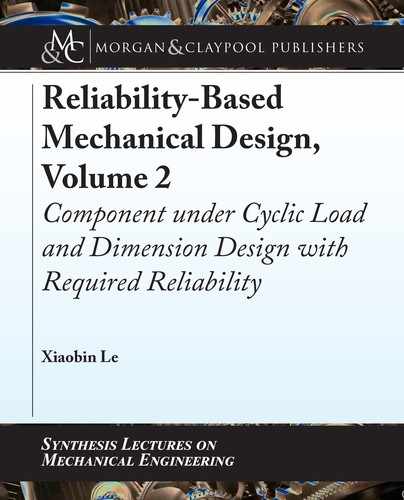
1
C H A P T E R 1
Introduction and Cyclic
Loading Spectrum
1.1 INTRODUCTION
Reliability-Based Mechanical Design consists of two separate books: Volume 1: Component under
Static Load and Volume 2: Component under Cyclic Load and Dimension Design with Required
Reliability.
is book is Volume 2. It is recommended that Volume 1 should be read first before Vol-
ume 2 since fundamental concepts of probability theory and their implementation in mechanical
design, as well as construction of the limit state function of a component under load are discussed
in detail. e following are some concise notes on topics previously discussed in Volume 1 but
that will be frequently used in this book.
Fundamental reliability mathematics, which discusses the fundamental concepts and def-
initions of probabilistic theory, is discussed in detail in Chapter 2 of Volume 1 [1]. e purpose
of this is to provide a foundation and basic understandings for implementing probability theory
in reliability-based mechanical design.
Computational methods of the reliability of a component, which discuss several com-
putational methods including the Hasoder–Lind (H-L) method, the Rachwitz–Fiessler (R-F)
method, and the Monte Carlo method, are discussed in Chapter 3 of Volume 1 [1]. e concise
description of their procedures and flowcharts are presented in Appendix A of this book.
In reliability-based mechanical design, component geometric dimensions, loads, and
stress concentration factor on a component are typically treated as random variables. ese are
discussed in detail in Chapter 4 of Volume 1 [1]. Since these will be frequently used in this
book, we concisely describe them here.
Component geometric dimension is a random variable because of its dimension toler-
ance. It is typically treated as a normally distributed random variable d . According to the
definition of dimension tolerance, the components’ dimension inside the dimension tolerance
range .d C t
L
; d C t
U
/ will be accepted. For a normal distribution, the probability of event
.
d
4
d
d
d
C 4
d
/ will be 99.9968%. is event can be used to represent the di-
mension tolerance range with a very small error (0.0032%). erefore, the mean and standard
deviation of a normally distributed dimension random variable d can be determined per Equa-

2 1. INTRODUCTION AND CYCLIC LOADING SPECTRUM
tion (1.1):
d
D
.
d C t
L
/
C
.
d C t
U
/
2
D d C
t
L
C t
U
2
d
D
.
d C t
U
/
.
d C t
L
/
8
D
t
U
t
L
8
;
(1.1)
where
d
and
d
are the mean and standard deviation of a normally distributed dimension d .
e type of distribution and its corresponding distribution parameters of an external load
will be calculated per the design specifications of a design case. If a load P such as concentrated
force, concentrated moment, or torque, is expressed as a range of value such as .P
low
; P
up
/, it
could be treated as a normally distributed random variable. We can use the same reasoning and
similar equation as Equation (1.1) to determine its mean and standard deviation:
P
D
P
low
C P
up
2
P
D
P
up
P
low
8
;
(1.2)
where
P
and
P
are the mean and standard deviation of a normally distributed load P .
e static stress concentration factor is a function of geometric shape and dimension.
Since the geometric dimension is a random variable, the stress concentration factor is also a
random variable and typically follows a normal distribution. We can use the following equations
to determine the mean and the standard deviation of stress concentration factor:
K
D 0:05
K
D K
Table
K
D
K
K
D 0:05K
Table
;
(1.3)
where
K
is the coefficient of variance of the static stress concentration factor. K
Table
is the stress
concentration factor obtained from tables in current design handbooks or design books.
K
and
K
are the mean and standard deviation of normally distributed static stress concentration
factors.
is book consists of three chapters and two appendixes. e concise outlines of each
chapter are as follows.
• Chapter 1: Introduction and Cyclic Loading Spectrum
is chapter explains the connection of this book with the first book: Reliability-Based
Mechanical Design, Volume1: Component under Static Load. en, this chapter presents a
systematic description of a cyclic load. Six models of cyclic loading spectrum will be pre-
sented and can be used to describe any type of cyclic load.
• Chapter 2: Reliability of a Component under a Cyclic Load
..................Content has been hidden....................
You can't read the all page of ebook, please click here login for view all page.
